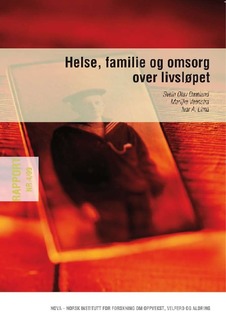| dc.description.abstract | Population ageing challenges in a fundamental way the balance between generations. Will families be able to balance between the needs of older and younger generations? Will societies be able to maintain the generational contract on which the welfare state is based? The present report contributes to these questions by describing how needs for help and care vary over the life-course, and by exploring how helping is organised and distributed between the family, the welfare state, and other helpers. This is one of two reports from the LOGG Health and care project which is based on data from the Life course generation and gender survey (LOGG, n=15 100, age 18-84), and financed by the Norwegian Ministry of Health and Long-term Care. Part I presents the background for the project and research questions. Part II describes how health and needs for help in daily life varies over the life course. Part III explores the distribution of help and helpers. The final Part IV confronts the actual help patterns with the ideal distribution of responsibilities between the family and the welfare state as stated in public opinion. As needs of close others may be as consequential as one's own needs are, the report describes and analyses family configurations, including the needs and help provisions of the respondents themselves and their partners, parents, and children. Part II shows that half of the population have developed a chronic health problem by the age they reach 61 (age 56 for women, 66 for men), but not all of them have activity limitations in daily life. This is the case for about one in five from age 50, increasing to about one in three in the early 80s. One in five need help to one or more IADL activities from the mid 70s onwards. Between 80 and 90 per cent of the adult population have children, of which 12 per cent have children with a chronic health condition. Parents are net providers of support to their children most of their lives, but when adult children are in the mid 50s, half have lost both their parents. Half of the remaining parents have then IADL needs (for practical help). Of parents with ADL needs (for personal care), about two out of three are institutionalized. Only few are «sandwiched» between parents and children in need of support; 6-7 per cent of the population in the 40s at the most, of which the great majority are also in paid work, of which some (mainly women) probably have adapted by taking a part-time job. Part III shows the great variation as to sources of help for different categories of persons in need. Partners help each other, with some support from family and services. Children are primarily a responsibility for the parents, with some support from other family members, while help to older parents seems to be rather equally distributed between the family and the services. Family help is dominant for lower levels of need, services are dominant among the more needy. The two parties are in reality mutually dependent, as the services contribute with hands-on care, while the family covers psycho-social needs and are active managers of the care system, in particular when needs are changing. Part IV confronts the actual distribution of responsibilities with the ideal balance as perceived in public opinion. This is done in a comparative context by contrasting Norway to other GGS countries. Parents are by popular opinion expected to take care of their sick children in all four countries, Norway, France, Bulgaria, and Georgia. However, care for older people is seen as a societal responsibility in Norway, supplemented by the family, and as a responsibility for the family in Georgia. France and Bulgaria are located in-between the two, with a popular preference for family care, but supplemented by the welfare state. Actual policies seem to be reasonably well in line with popular opinion in the Norwegian case. In fact, the Norwegian population would have preferred even more welfare stateresponsibility than today, thus there is no support in public opinion for a more family-oriented elder care in Norway. | en |
